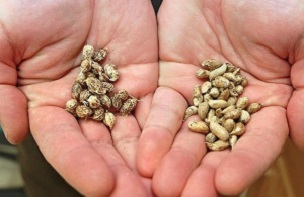Decoding the Peanut
Key Facts
• ARS scientists helped decode the modern peanut’s genome.
• This work will help find genes for resistance to pests like root knot nematodes.
• Finding those genes will speed development of improved peanut varieties.
• Peanut growers spend $25-30 million annually to control root knot nematodes.
Scientists think that these two wild ancestors merged 10,000 years ago
to form today's peanut
Over the past couple years, an archaeological dig—of the genetic
kind—has been in the works to uncover the complex beginnings of the
beloved peanut, Arachis hypogaea.
Major headway was made in
2014, when an international team of scientists from the Agricultural
Research Service (ARS), University of Georgia, and other organizations
announced the completion of a first-draft sequence of the peanut’s book
of life—or “genome.”
The team accomplished the feat using
cutting-edge tools to decode the order of the DNA bases that make up
the genomes of the modern peanut’s wild ancestors, which merged long
ago to form the cultivated species grown today as a source of
high-quality cooking oil and nutritious food.
A research paper
published in the February 2016 issue of Nature Genetics describes the
results of the team’s draft genome-sequencing efforts. The advance
should speed efforts to breed new peanut varieties that have desirable
traits like higher yield; longer shelf life; and greater resilience to
pests, diseases, and drought.
According to Steven Cannon, one of
four ARS participants on the Peanut Genome Project, the effort uncovers
most of the genes and regulatory elements necessary for making a peanut
plant. That’s no small task, considering that the modern-day peanut’s
genome totals about 2.7 billion base pairs—a size approaching that of
the human genome (3 billion base pairs).
The Nature Genetics
paper clarifies humankind’s domestication of these ancestral peanuts,
says Cannon, a plant geneticist at the ARS Corn Insects and Crop
Genetics Research Unit in Ames, Iowa. “It is a bit of living genetic
archaeology in the sense that the genome sequences tell us about how,
where, and when the ancestor species came together to become the peanut
that is grown by farmers now.”
Scientists believe the merger
happened 9,000 to 10,000 years ago—quite possibly from wild peanut
plants cross-pollinating in the hardscrabble plots of prehistoric
farmers in what is today southeastern Bolivia.
One application
of the latest sequencing effort will be the use of “molecular
markers”—specific genomic regions that can flag the presence of nearby
genes of interest, such as those for resistance to pests like the
root-knot nematode. Using technology to detect the markers, for
example, peanut breeders can check and select for the resistance trait
in seedlings instead of growing the plants to maturity, infecting them
with nematodes, and waiting for symptoms to appear.
Ultimately,
such “marker-assisted selection” should help speed commercialization of
sturdy new varieties with nematode resistance that will cut the need
for chemical controls—an expense that costs U.S. peanut growers $25-30
million annually.
Scientists from nine countries participated in
this phase of the Peanut Genome Project. Contributions by the ARS
members Cannon, Brian Scheffler, and Baozhu Guo, as well as Noelle
Barkley (formerly with ARS), included providing bioinformatics support,
peanut germplasm resources, and data to help describe and analyze
genomic points of interest.—By Jan Suszkiw, ARS Office of
Communications.
|
